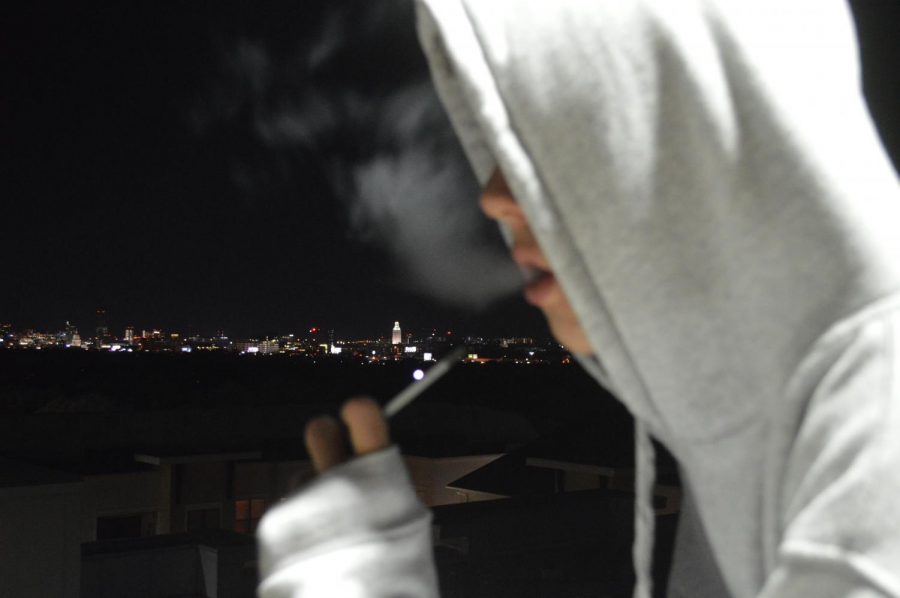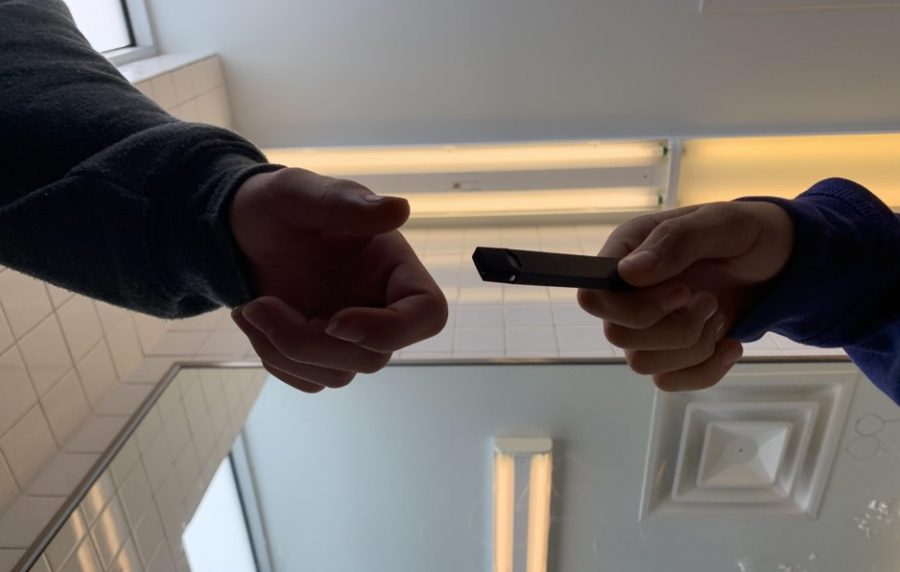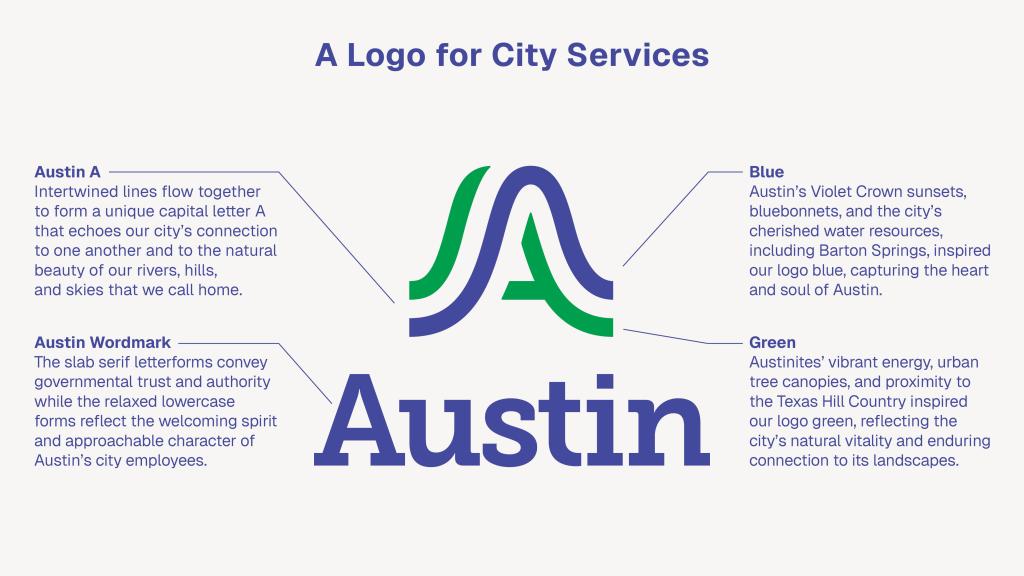As class begins, no one’s really concerned about the 14-year-olds trying out their new mango pods in the science hall bathroom, but everyone knows about it. Whether you’ve walked into the familiar fruity scent, or seen the pack of freshman stumble out of the bathroom coughing, it’s no secret Juuling has found its way into our school.
Vapes get used everywhere from bathrooms, to classrooms and even on buses. The reason why people choose to use them in these settings is because the vapes are so small that adults often don’t notice them. Vapes may not be visible to everyone, but everyone can certainly smell them. Even though vape fluid evaporates quite quickly the scent doesn’t usually go with it, unfortunately, both for everyone else in the room (or in some cases bus) and for the kids who gets caught by its characteristic smell.
In addition, some schools, including Austin ISD schools, are beginning to crack down on vaping on campus.
“The district leaves it up to the campus to adopt a policy as far as how to enforce it,” McCallum High School assistant principal Andrew Baxa said. “The district basically says you’re not allowed to do it.”
Along with the growing problem of vaping in schools, the punishments for doing it are growing as well.
“We want to drive home a message that it’s not acceptable on our campus at any time,” Baxa said. “It got to be a huge problem last year and that’s why we upped the penalty this year from ISS to a three-day home suspension.”
The San Francisco based company, Juul, was started by two Stanford alumni seeking smoking alternatives for adults. Originally created to wean adults from their smoking habits, it’s had the reverse effect on teens. With 59 mg/mL of nicotine in each pod, the brand has over 70 percent of the e-cigarette market.
Most recently, the FDA has released a statement banning JUUL’s flavored pods as it appeals to teens, pushing them further towards addiction. The flavors stores have in stock now are all that’s left. The company is sticking to its mission of helping adult smokers, however, and is keeping mint, tobacco and menthol flavors in retail stores.
We’ve all read about JUUL and the negative health effects it can have on its user in the articles written by the adults who didn’t have vaping around in their teen years. We’ve all heard about it from parents’ perspective.
When asked about the FDA’s decision to restrict JUUL, a McCallum student who requested anonymity said, “It’s not like it did much,” a McCallum student said. “They kept the better flavors and there’s always a way to get the others.”
The company is also stopping all social media promotions to slow the epidemic of teen vaping. With an Instagram account of more than 76,000 followers, the company made a final post stating, “#JUUL Instagram account will no longer be active as of November 13, 2018.”
While still on the mission to cure adult smokers, the website is still up and students are still using it as a resource.
Though teens may not see it, peer pressure plays a bigger part than they realize. Vaping is everywhere, no matter the event. Whether it be a high school party or the bathrooms at school.
“Just being around people who do it gets the thought in your head to at least consider it,” one McCallum parent said.
Though some students are immediately hooked, many begin as skeptics to the fad but become open to it through increased exposure. Watching others students use their JUULs and not seeing an immediate effect makes it easier for students to partake without looking at the cost.
“Well, I honestly thought it was stupid. … I thought I’d never get into it myself but then I thought, what’s the harm?” a McCallum student said. Though vapes are 95 percent safer than cigarettes, it turns 30.7 percent of e-cig users into smokers.
Some students have said they vape for stress relief or they just do it recreationally. Though these students claim not to be hooked on nicotine, on average those interviewed will go through four pods a week. A McCallum student even admitted, ”One time I gave myself nicotine poisoning, and I just felt terrible all day. … I had to take a break.”
Juuls are regularly sold in smoke shops and gas stations everywhere. While the legal age of use is eighteen, students are said to get by with fake IDs,having their older friends buy for them, or even just hope that they don’t get carded. Students will go as far as ordering vape products from online stores as some sites don’t ID their buyers, then signing off on packages as their parents.
Older students have even taken it upon themselves to sell to underclassmen.
“I got my first Juul from my 18-year-old senior friend, but I’ve definitely heard of people upcharging underaged kids,” said one student who requested anonymity.
Beginning with the initial charge of $40, the cost piles up. Some students vape up to a pack of four pods a day, averaging to a cost of $75 a week. While not everyone vaping does it this frequently, there’s no way around the dent the habit leave in your pocket.
Many schools have tried to help students with an intervention like nicotine patches and gums and coping techniques for when they feel like they need to vape. These can help, but teens should be monitored because depression and other mental health disorders can develop when adolescents use nicotine.
In essence, there’s a literal and personal cost to the lifestyle. Usually started as a joke, vaping is a legitimate concern that a large group of students have played some part in. Though it is a fairly recent fad, vaping’s effects will be felt for many years to come.

The prevalence of vaping on campus has raised concerns that students are forming a habit without full awareness of the health risks and criminal liability that are incurring by vaping.









Risa • Jan 18, 2019 at 4:00 pm
I really like how informative and organized this piece was. I also learned a lot of things I didn’t know about vaping through this article.
Anonymous • Jan 18, 2019 at 3:44 pm
Honestly vaping is a bad thing, I don’t like it and its bad for your body. If you vape it will mess up your metabolism and destroy your life forever if you continue doing it. But here are my honest thoughts!
I come from the EU where smoking is a “Normal thing”. Everyone at my old school smoked, not vape, smoked cigs. Now there were no penalties if you were caught smoking, no one cared if you smoked in front of the school, but the teachers were always telling us “If you want to smoke, smoke but you are killing yourself”.
My opinion on smoking stays the same, but honestly in my opinion if someone wants to smoke let them smoke, but do it outside but here its not the case, you make these kids risk smoking in the bathrooms just because you don’t let them do it outside. IF you get caught do it outside its the same as if you get caught inside. But if you let them smoke outside away from others (not in the bathroom) then I think its ok because like this you’re making these kids smoke in the bathroom, and some people don’t like the smoke of vape and they have to deal with it.